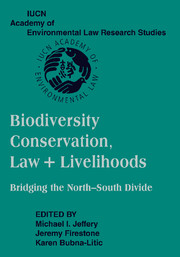 Biodiversity Conservation, Law and Livelihoods: Bridging the North-South Divide
Biodiversity Conservation, Law and Livelihoods: Bridging the North-South Divide Published online by Cambridge University Press: 31 July 2009
Nearly forty years ago, when environmental law was first emerging as a subject, the background was effectively one of legal anarchy. Industrial emissions into the air and water were uncontrolled and unlimited. Waste materials, however toxic, were buried at any convenient site, and records were not even routinely maintained of their location or magnitude, nor was there monitoring of their movement into water courses or aquifers. DDT and other chlorinated hydrocarbon pesticides were liberally applied and the only regulation (in the United States, for example) was whether the labels under which they were sold accurately described their contents. As an example of how different things were then, in one of our earliest environmental cases, in 1967, where an effort was being made to protect a wildlife sanctuary against the expropriation of a right-of-way for a gas transmission line, the judge said in open court, “Before this case started I looked up the meaning of [the word] ecology in the dictionary because I noted it [in the case documents before me]. I was not aware of that word before.”
The situation was extreme, and attention was focused, as it should have been, on the sometimes disastrous consequences of then-current and commonplace practices, notably on such tragic matters as the methyl mercury poisoning in Japan that came to be known as Minamata disease; and leading to such catalyzing events as the Tokyo International Conference on Environment organized in March 1970, under the leadership of Professor Shigeto Tsuru.
To save this book to your Kindle, first ensure [email protected] is added to your Approved Personal Document E-mail List under your Personal Document Settings on the Manage Your Content and Devices page of your Amazon account. Then enter the ‘name’ part of your Kindle email address below. Find out more about saving to your Kindle.
Note you can select to save to either the @free.kindle.com or @kindle.com variations. ‘@free.kindle.com’ emails are free but can only be saved to your device when it is connected to wi-fi. ‘@kindle.com’ emails can be delivered even when you are not connected to wi-fi, but note that service fees apply.
Find out more about the Kindle Personal Document Service.
To save content items to your account, please confirm that you agree to abide by our usage policies. If this is the first time you use this feature, you will be asked to authorise Cambridge Core to connect with your account. Find out more about saving content to Dropbox.
To save content items to your account, please confirm that you agree to abide by our usage policies. If this is the first time you use this feature, you will be asked to authorise Cambridge Core to connect with your account. Find out more about saving content to Google Drive.